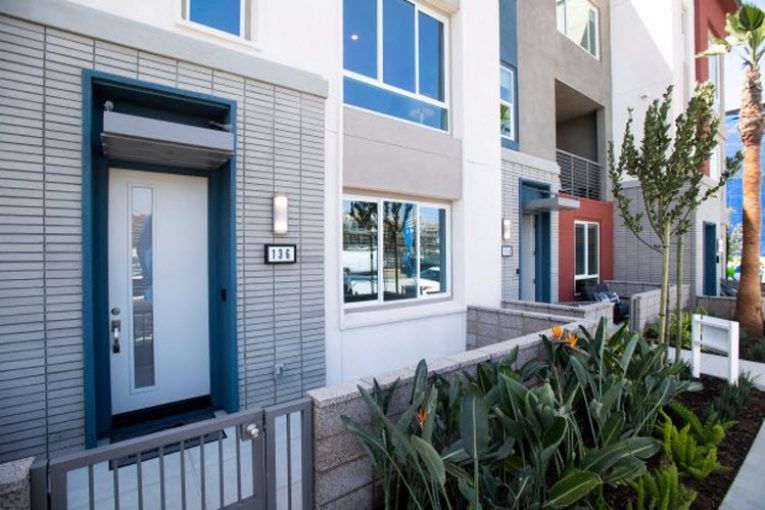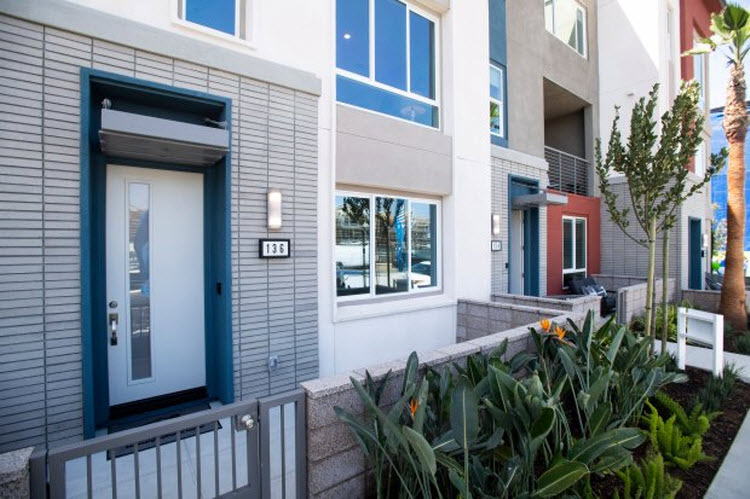

On Tuesday the city council will be looking at amending the energy efficiency code to require that mixed-fuel single-family dwellings and low-rise multi-family residential projects to achieve a total Energy Design Rating (EDR) margin of 9.5 for SFD and 10 for low-rise multi-family, per the cost effectiveness study prepared by Frontier Energy and Misti Bruceri & Associates.
It would also require pre-wiring for a future retrofit to all-electric appliances in mixed-fuel new single-family dwellings and low-rise multi-family buildings.
The city has a long history of energy efficiency and sustainability requirements going back to the 1970s, and most recently in 2008 with the first green building ordinance in the region and the most comprehensive in the state.
The city continues with a new proposal that will incentivize all-electric in single-family dwelling as well as low rise multi-family buildings.
City staff notes, “The proposed Ordinance will be consistent with all of the reach codes adopted over the last 12 years by requiring a cost effective compliance margin.
“Full CALGreen, Tier I compliance regarding energy efficiency has not been found to be cost effective, therefore the proposed Ordinance will require a total Energy Design Rating (EDR) margin of 9.5 for SFD and 10 for low-rise multifamily consistent with the cost effectiveness study”
The California Energy Commission has approved the 2019 California Energy Code, going into effect on January 1, 2020. This code requires single-family and multifamily low-rise buildings to “offset  100% of the electricity used on site, excluding some specific electrical loads.”
100% of the electricity used on site, excluding some specific electrical loads.”
The purpose of this is “to take the additional step of providing a path to reduce the use of fossil fuels in residential buildings.”
Staff notes that since 2008 the City “has enacted an energy efficiency reach code that requires projects to go beyond the requirements of both the California Energy Code and the California Green Building Standards Code (CAL Green) to a point that is cost effective.”
The only difference with this proposed Ordinance is that all-electric homes will not be required to go beyond the minimum code requirements.
City staff views this requirement as responsive to the resolution that declared a climate emergency and called on the city to take steps to restore a safe climate that includes “an acceleration of the carbon neutrality goal for the Davis community from 2050 to 2040.”
The staff report notes that staff has analyzed the potential for requirements that all new residential buildings go all-electric – as some of the recent developments have done voluntarily.
However, they worry that there is the potential for residences from the building community which “could possibly result in litigation as it is not found to be cost-effective at this time.” Thus staff views this as an alternative, where they “incentivize” rather than “require” all-electric buildings.
They write: “As an incentive for all-electric homes, the proposed Ordinance would not include additional energy efficiency requirements beyond code compliance for homes that do not utilize fossil fuels. To facilitate future retrofits for mixed-fuel homes, the proposed Ordinance will require pre-wiring for electric appliances.”
The city has for the most part “relied upon negotiated Development Agreements with larger developments to achieve voluntary agreement to comply with energy efficiency and PV provisions that may not otherwise be enforceable, absent a Development Agreement.”
They add, “A cost effectiveness study allows the City is to adopt local ‘reach codes’ exceeding the standard State energy efficiency requirements, eliminating the need to negotiate such requirements on a project-by-project basis, and providing for consistency amongst projects.”
Staff writes: “Single-family dwellings that are constructed as mixed-fuel dwellings that meet a total EDR margin of 9.5 will cost approximately $5045 more than the Standard Design code compliant house.
“The percentage of savings will be approximately 17% and the emissions savings will be approximately .35 lbs.-CO2/sf/year. A 2000 sq. ft. home will save 700 lbs. of CO2 per year.”
Staff projects that “In new developments, single-family dwellings that are constructed as all-electric homes will see an approximate savings in natural gas infrastructure cost of $5349 per home as gas infrastructure could be eliminated as part of the overall development.
In addition, “For new single-family homes built on an infill lot where gas infrastructure has already been installed, the upfront cost savings would be less. The home would save the costs of the gas piping in the home and the elimination of the service run from the street but would not have the benefit of cost-savings for elimination of the utility installed beneath the roadways.”
—David M. Greenwald reporting


I was looking up the WDAAC requirements:
”All for sale homes, cottages, bungalows and condominiums to be zero net electric usage as defined by the 2020 California Green Standards with individual or shared photovoltaic systems”
“Developer shall provide an all-electric model home which shall demonstrate available electric appliances and features that may serve as a substitute for natural gas appliances. The demonstration model home will serve the entire subdivision regardless of builder or residential unit type and shall remain for a minimum of 36 months from public opening. Each builder shall be required to offer the demonstrated appliances or features, or an all- electric equivalent, in its housing product. It is the intent that all builders will provide at this model home a menu of offerings of electric appliances and features, and the associated costs, for their particular home. Furthermore, to incentivize the development of all-electric homes, Developer shall contribute $1,000 to purchasers of homes who elect to construct with all-electric appliances and features.”
Seems like if WDAAC can meet these standards, they should be universal.
I don’t understand the obsession with all-electric and ridding new construction (and, I assume, eventually all buildings) of natural gas. Perhaps I’m biased because I like cooking with gas . . . . . ha!
Natural gas has very few emissions and is abundant. It is an ideal vehicle fuel, if we would push our resources in that direction, but it gets a bad wrap as a ‘fossil fuel’. Unfortunately, we burn it en-masse to produce electricity in uber-expensive power-plants built via corrupted contracts from the Grey Davis administration.
Natural gas is basically a fossil fuel that releases GHG into the atmosphere upon burning.
As are many of the sources of electricity, including NG, coal and coal gas… duh…
Many would say that hydro-power and geo-thermal power have severe environmental consequences… photo-voltaic , wind turbine equipment is manufactured via processes that generate a whole lot of GHG (they require electricity, coal based sources [steel is iron and carbon, and both mining processes generate GHG]… cows[who can create methane,as well], and human breathing create a bunch of GHG… as do trees (although those offset somewhat, until they die, decay, burn, etc.). They don’t call them the Great Smoky Mountains for nothing!…
It is what it is.
Climate change is real, and has been going on for millions of year, with swings from global cooling and global warming, and some periods of stability. That is a FACT. Anyone disputing that is clueless… but cause and what [if anything] we can/should do about it, and to what effect, is very open to debate.
But, unless you stop breathing, then commit your body to a hermetically sealed tomb, everyone one of us create GHG, everyday.
Like Alan, I cook w/NG, as does our WH, and Dryer… over the years, less volatile, cheaper, and as I learned to ‘cook with gas’, have better control. Can conserve better…
Perhaps, for those who oppose all fossil fuel use, they should rely on systems that never had fossil fuels in their equipment, and delivery system sources…
Or demand everyone “retrofit”
Bill – you’re comment is either silly or uninformed.
“The largest source of greenhouse gas emissions from human activities in the United States is from burning fossil fuels for electricity, heat, and transportation.”
Soure = EPA
By ‘volatile’ I meant ‘price’ of energy…
Silly? Ill-informed?
Your own chart shows GHG due to production of electricity is 1% off of #1, transportation (electricity is close #2)!
Yet use of my gas dryer, gas heater, gas stove is within “residential and commercial”, less than half that (in aggregate), and probably nearly trivial if disaggregated…
I wrote,
I stand by that.
I deny being silly or uninformed… perhaps toi?
And, even if I would concede that (which I am far from doing), then sure looks, according to your apparent argument, you should call for mandatory retrofits to eliminate all gas heaters (space and water) and use for cooking.
Interesting response. Most of your comment was about human production, which is less than 10 percent and probably a good deal less than even that. That’s what I considered silly. Here’s the thing with production of electricity versus natural case – 100 percent of natural gas is producing GHG, increasingly electricity is coming from cleaner sources. That’s why the shift from natural gas to electrity, it is leading to a huge decrease in GHG.